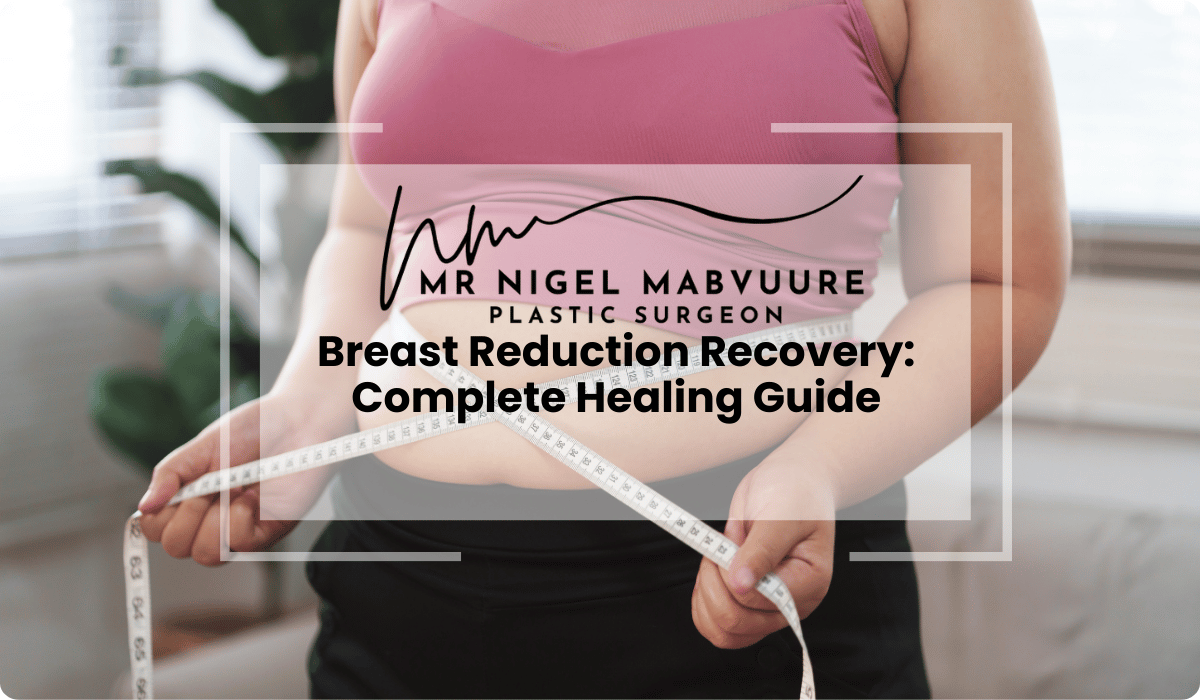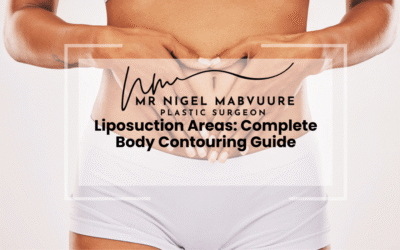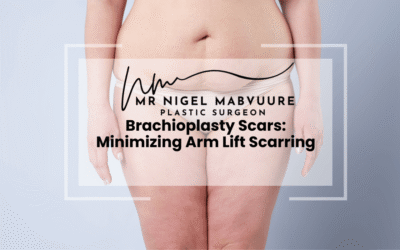Successful Breast Reduction Recovery
- Recovery follows a predictable timeline: intense discomfort for 24-48 hours, significant improvement by week 1, and return to most normal activities by 6-8 weeks.
- Effective pain management combines prescribed medications, cold compresses, proper positioning, and gentle movement as advised by your surgeon.
- Wearing a specialized surgical compression bra continuously for 4-6 weeks is crucial for supporting healing tissues and minimizing swelling.
- Exercise should be gradually reintroduced: gentle walking immediately, light lower body exercises at 2-4 weeks, and full routines including upper body workouts after 6-8 weeks with surgeon approval.
- Monitor for complications like infection, bleeding, delayed wound healing, or sensation changes, and contact your surgeon promptly if concerning symptoms develop.
- Scars will fade over 6-12 months; enhance healing with silicone products, gentle massage, sun protection, and compression as directed.
- Lifestyle improvements extend beyond aesthetics to include pain relief, improved physical activity, expanded clothing options, better sleep quality, and enhanced psychological wellbeing.
Table of Contents
- What to Expect During Breast Reduction Recovery Timeline
- Managing Pain and Discomfort After Reduction Mammoplasty
- Post-Operative Care: Surgical Bras and Wound Management
- When Can I Return to Normal Activities After Breast Reduction?
- Potential Complications and When to Contact Your Surgeon
- Long-Term Results and Scar Management Techniques
- How Will My Lifestyle Improve After Breast Reduction Recovery?
What to Expect During Breast Reduction Recovery Timeline
Breast reduction recovery follows a predictable timeline that helps patients understand what to expect during the healing process. Understanding this breast reduction timeline is crucial for proper planning and ensuring optimal results. Most patients at All Skin Surgery London experience a similar progression, though individual healing rates may vary.
The first 24-48 hours after surgery are typically the most challenging. During this period, you’ll likely experience significant swelling, bruising, and discomfort. Drainage tubes may be in place to prevent fluid accumulation, and you’ll be wearing a surgical compression bra to support your new breast contours.
By the end of the first week, most patients notice a significant reduction in pain. Your surgeon will likely remove any drainage tubes and non-dissolving stitches during your follow-up appointment. While you’ll still need to limit your activities, many patients feel comfortable enough to return to light desk work.
Weeks 2-4 mark continued improvement in comfort levels. Swelling gradually subsides, though some residual swelling may persist. Most patients can resume light activities but should continue avoiding strenuous exercise, heavy lifting, and activities that could impact the chest area.
By 6-8 weeks post-surgery, many patients have recovered sufficiently to resume most normal activities, including more vigorous exercise (with surgeon approval). The final results of your breast reduction will continue to develop over the following months as all swelling resolves and tissues settle.
Managing Pain and Discomfort After Reduction Mammoplasty
Effective pain management is a crucial component of reduction mammoplasty healing. Most patients experience moderate discomfort rather than severe pain, which can be successfully managed with appropriate medications and self-care techniques. Our surgeons at All Skin Surgery’s breast reduction clinic provide comprehensive pain management protocols tailored to each patient’s needs.
Prescription pain medications are typically provided for the first few days following surgery. These may include opioid-based medications for short-term use, gradually transitioning to over-the-counter options like paracetamol or ibuprofen (if not contraindicated). It’s important to take medications as prescribed rather than waiting for pain to become severe.
Cold compresses can significantly reduce swelling and discomfort. Apply ice packs wrapped in a thin cloth to the sides of the breasts (never directly on surgical sites) for 20 minutes at a time with at least 20-minute breaks between applications. This is particularly effective during the first 48-72 hours.
Proper positioning also plays a vital role in breast reduction pain management. Sleeping in a semi-reclined position with pillows supporting your back and sides helps reduce pressure on the surgical sites and minimises discomfort. Many patients find that a recliner chair is ideal during the early recovery period.
Gentle movement, as advised by your surgeon, can help reduce stiffness and promote circulation. However, it’s crucial to avoid movements that strain the chest muscles or surgical sites. Deep breathing exercises can also help manage discomfort while promoting lung health after anaesthesia.
Post-Operative Care: Surgical Bras and Wound Management
Proper post breast reduction care is essential for optimal healing and aesthetic outcomes. A key component of this care involves wearing the appropriate surgical bra and managing your incision sites with diligence. Following your surgeon’s specific instructions will significantly reduce complications and improve your overall recovery experience.
The surgical bra after reduction plays a crucial role in supporting your newly contoured breasts and minimising swelling. Unlike regular bras, these specialised compression garments provide gentle, even pressure across the entire breast tissue without underwires that could irritate incisions. You’ll likely need to wear this bra continuously for 4-6 weeks, removing it only for showering as directed by your surgeon. Many patients find it beneficial to have at least two surgical bras to allow for washing.
Wound care is another vital aspect of post-operative management. Your surgeon will provide specific instructions, but generally, incisions should be kept clean and dry. After showering (once permitted), gently pat the area dry rather than rubbing. Avoid applying creams, lotions, or ointments to the incision sites unless specifically prescribed by your surgeon.
Dressings will initially cover your incisions, and your surgeon will advise when and how these should be changed. Some surgeons use waterproof dressings that can remain in place for several days, while others may require daily dressing changes. It’s essential to wash your hands thoroughly before touching the surgical area to prevent infection.
Monitor your incisions daily for signs of proper healing. Some clear or slightly blood-tinged drainage is normal in the first few days. However, increasing redness, warmth, unusual swelling, pus, or foul odour could indicate infection and should be reported to your surgeon immediately.
When Can I Return to Normal Activities After Breast Reduction?
One of the most common questions patients ask concerns the timeline for returning to work after breast reduction and resuming normal activities. Recovery varies between individuals, but following these general guidelines will help ensure proper healing while minimising the risk of complications.
Most patients can return to desk-based or light work within 1-2 weeks after surgery. However, jobs requiring physical exertion, heavy lifting, or extensive arm movements may require 3-4 weeks off. When returning to work, consider wearing loose, comfortable clothing that doesn’t put pressure on your chest area. Some patients find that scheduling shorter workdays initially helps ease the transition back to full-time employment.
Breast reduction exercise restrictions are particularly important to understand. Light walking is encouraged almost immediately after surgery to promote circulation and prevent blood clots. However, more strenuous activities must be gradually reintroduced:
- Weeks 1-2: Focus on gentle walking only
- Weeks 2-4: Light lower body exercises may be permitted, avoiding movements that bounce or strain the chest
- Weeks 4-6: Moderate cardio may be introduced, still avoiding chest-focused exercises
- After 6-8 weeks: Most patients can resume full exercise routines, including upper body workouts, with surgeon approval
For those wondering “when can I sleep on my stomach after breast reduction?”, patience is key. Most surgeons recommend sleeping on your back in a slightly elevated position for at least 4-6 weeks. Stomach sleeping puts direct pressure on the healing tissues and can affect the final shape of your breasts. Side sleeping may be gradually introduced after 2-3 weeks, using pillows for support.
Regarding intimate activities, most surgeons advise waiting at least 3-4 weeks before resuming sexual activity, and then proceeding gently with positions that don’t put pressure on the chest. Always follow your surgeon’s specific guidance, as individual healing rates vary.
Potential Complications and When to Contact Your Surgeon
While breast reduction is generally safe, understanding potential breast reduction complications is essential for early intervention if issues arise. Most complications are minor and treatable when addressed promptly, which is why knowing when to contact your surgeon is crucial for optimal recovery.
Infection is one of the most common complications, typically presenting within the first week after surgery. Signs include increasing redness, warmth, swelling, pus-like discharge, or fever above 38°C. If you notice these symptoms, contact your surgeon immediately as antibiotic treatment may be necessary.
Bleeding or haematoma formation can occur in the first 24-48 hours after surgery. Symptoms include sudden swelling, severe pain, or bruising that seems to be rapidly expanding. This requires immediate medical attention as it may necessitate surgical intervention to prevent tissue damage.
Delayed wound healing sometimes occurs, particularly at the junction where incisions meet (such as the T-junction in an anchor-pattern reduction). Minor wound separation may be managed with special dressings and careful monitoring, but significant openings require prompt surgical evaluation.
Changes in nipple sensation are common after breast reduction. While temporary numbness or hypersensitivity often resolves within months, permanent changes can occur. Contact your surgeon if you experience complete loss of sensation that doesn’t improve over time.
Seroma (fluid collection) may develop after drainage tubes are removed. These fluid pockets may feel like soft, mobile swellings and sometimes require aspiration by your surgeon. Regular follow-up appointments help identify these issues early.
More serious but rare complications include tissue necrosis (death of breast tissue or nipple) and deep vein thrombosis. Any signs of darkening or blackening of tissue, severe pain in the legs, shortness of breath, or chest pain warrant immediate emergency attention.
Long-Term Results and Scar Management Techniques
Breast reduction results continue to evolve long after the initial recovery period. While you’ll notice immediate changes in breast size, the final aesthetic outcome develops over 6-12 months as swelling completely resolves and tissues settle. Understanding this timeline helps manage expectations and appreciate the progressive improvement in both appearance and comfort.
One of the most common questions patients ask is “will breast reduction scars fade?” The answer is yes, but this process takes time. Initially, scars appear red or pink and may be raised. Over months, they typically fade to a lighter colour and flatten, becoming less noticeable. However, scars are permanent and their final appearance varies based on individual healing factors, genetics, and post-operative care.
Effective scar management begins approximately 2-3 weeks after surgery, once incisions have fully closed. Several evidence-based techniques can significantly improve scar appearance:
- Silicone sheets or gel: Applied directly to healed incisions, silicone products have been clinically proven to improve scar appearance by maintaining moisture and reducing collagen production.
- Scar massage: Gentle massage of healed scars can break down scar tissue and improve flexibility. Your surgeon will demonstrate proper technique and timing.
- Sun protection: Scars are highly susceptible to sun damage, which can cause permanent darkening. Keep scars covered or apply SPF 50+ sunscreen for at least 12 months post-surgery.
- Compression: Your surgical bra provides gentle compression that helps flatten scars during early healing.
For patients with more pronounced scarring, additional treatments may be recommended after the initial healing period. These might include steroid injections for thickened scars, laser therapy to reduce redness, or microneedling to improve texture. These interventions are typically considered after the 6-month mark when scars have matured.
It’s important to maintain realistic expectations about scarring. While techniques can significantly improve appearance, some degree of scarring is an inevitable trade-off for the significant benefits of breast reduction. Most patients find that the improvement in physical comfort and body proportion far outweighs concerns about scarring, which becomes less noticeable over time.
How Will My Lifestyle Improve After Breast Reduction Recovery?
The breast reduction recovery journey culminates in significant lifestyle improvements that extend far beyond aesthetic changes. Patients consistently report that these quality-of-life enhancements make the recovery process worthwhile, with benefits becoming increasingly apparent as healing progresses.
Physical discomfort relief is often the most immediate and dramatic improvement. The chronic neck, shoulder, and back pain that prompted many to seek surgery typically diminishes significantly or resolves completely. This reduction in pain often leads to improved posture as patients no longer hunch forward to compensate for breast weight. Many report being able to stand taller and straighter without discomfort.
Exercise and physical activity become more accessible and enjoyable after recovery. Activities that were once uncomfortable or embarrassing—such as running, jumping, or high-impact sports—become possible without pain or excessive breast movement. This newfound physical freedom often encourages a more active lifestyle, contributing to overall health improvements.
Clothing options expand dramatically after breast reduction. Many patients describe the joy of shopping for clothes that fit properly without requiring alteration. Button-up shirts close without gapping, dresses fit both bust and waist simultaneously, and patients can wear styles they previously avoided. This expanded wardrobe choice often contributes to improved self-confidence and body image.
Sleep quality improvements are frequently reported, as patients can comfortably sleep in positions that were previously painful. The elimination of skin irritation and rashes under the breasts also contributes to overall comfort and hygiene. Many patients note that these practical daily benefits significantly impact their overall quality of life.
Psychological benefits, while less visible than physical changes, are equally important. Many patients report improved self-confidence, reduced self-consciousness, and a more positive body image. The freedom from unwanted attention and the ability to participate more fully in social and physical activities often leads to enhanced emotional wellbeing.
While the recovery process requires patience, the long-term lifestyle improvements make breast reduction one of the procedures with the highest patient satisfaction rates in plastic surgery. Most patients report that they wish they had undergone the procedure sooner, highlighting the significant positive impact on daily life and overall wellbeing.
Frequently Asked Questions
How long is the recovery period after breast reduction surgery?
The complete recovery period after breast reduction typically spans 6-8 weeks. Most patients can return to desk work within 1-2 weeks, resume light activities after 2-4 weeks, and return to full exercise including upper body workouts after 6-8 weeks with surgeon approval. However, the final results continue to develop over 6-12 months as all swelling resolves and tissues settle.
When can I stop wearing a surgical bra after breast reduction?
Most surgeons recommend wearing a surgical compression bra continuously for 4-6 weeks after breast reduction, removing it only for showering as directed. After this initial period, you may transition to supportive sports bras for another 2-4 weeks before returning to regular bras without underwires. Always follow your surgeon’s specific instructions, as individual healing needs may vary.
What pain management options are available after breast reduction?
Pain management after breast reduction typically includes prescription medications for the first few days, transitioning to over-the-counter options like paracetamol or ibuprofen. Additional relief methods include cold compresses applied to the sides of the breasts for 20 minutes at a time, sleeping in a semi-reclined position with pillow support, and gentle movement as advised by your surgeon to reduce stiffness.
When will breast reduction scars fade?
Breast reduction scars begin to fade from red or pink to a lighter color over 6-12 months. While scars are permanent, their appearance improves significantly with proper care including silicone sheets or gel, gentle scar massage, strict sun protection, and compression. The final appearance varies based on individual healing factors, genetics, and post-operative care techniques.
What are the warning signs of complications after breast reduction?
Warning signs that require immediate contact with your surgeon include: increasing redness, warmth or swelling around incisions; fever above 38°C; pus-like discharge; sudden swelling or expanding bruising; significant wound separation; complete loss of sensation that doesn’t improve; darkening or blackening of tissue; severe leg pain; shortness of breath; or chest pain. Early intervention is crucial for addressing potential complications.
When can I sleep on my side or stomach after breast reduction?
Most surgeons recommend sleeping on your back in a slightly elevated position for at least 4-6 weeks after breast reduction. Side sleeping may be gradually introduced after 2-3 weeks with proper pillow support. Stomach sleeping should be avoided for at least 6-8 weeks as it puts direct pressure on healing tissues and can affect the final shape of your breasts. Always follow your surgeon’s specific guidance.
What lifestyle improvements can I expect after breast reduction recovery?
After breast reduction recovery, patients typically experience significant lifestyle improvements including relief from neck, shoulder and back pain; improved posture; greater ability to exercise comfortably; expanded clothing options that fit properly; better sleep quality; reduced skin irritation; and psychological benefits such as improved self-confidence and body image. These quality-of-life enhancements contribute to breast reduction having one of the highest satisfaction rates among plastic surgery procedures.




